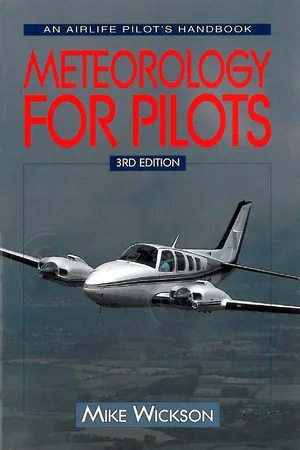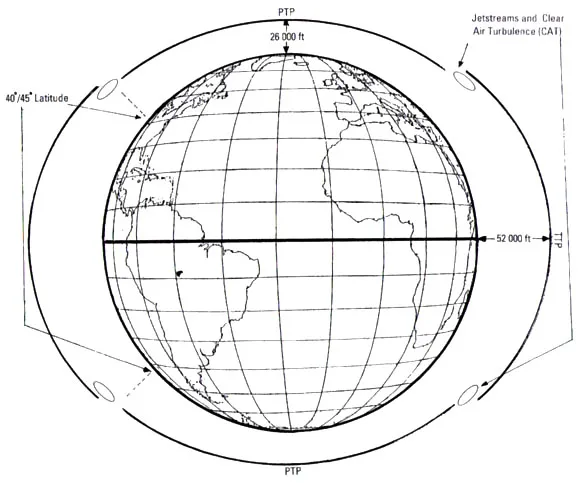![]()
Chapter 1
The Atmosphere
The atmosphere can be considered as an ocean of air which rotates with the earth and is supported by the earth’s surface at the base and extends to the fringes of space at the top. There are three warm regions of the atmosphere which are heated by solar radiation reacting on the atmospheric particles, and there are two relatively cold atmospheric regions. These five layers are shown diagrammatically at Figure 1.1. It should be noted that boundary heights for these regions can vary considerably.
Figure 1.1. Five Layers of the Atmosphere
The Exosphere
This is the uppermost atmospheric layer where gas density is very low and some air particles can escape from the earth’s gravitation. This warm region is at heights greater than 700 km.
The Ionosphere
This is the warm region below the exosphere and extends to within about 80 km of the earth’s surface. It is a region where much of the air becomes ionised, that is, positively charged by the action of ultra-violet and X-ray solar radiation. There are separate layers within the ionosphere with different heights and degrees of ionisation. These separate layers; D, E, F1 and F2 have a profound effect on the transmission of certain radio waves and can be used to increase considerably the range of navigational aids and communications for aircraft.
The Mesosphere
This is a cold layer which can extend from about 50 km to 80 km above the earth’s surface and is immediately below the ionosphere. The main characteristic is a steep temperature lapse rate, so it is a region becoming colder with increase of height.
The Stratosphere
This is the third warm region of the atmosphere which extends from about 11 km to 50 km. The heat is provided by a layer of ozone which traps ultra-violet radiation from the sun and then retransmits this as infra-red heat. The depth of the ozone layer varies with latitude and in recent years there has been evidence of gaps or holes in the layer, particularly above the South Pole. Here a definite lack of ozone has been established covering a large area, commensurate with the land mass and embracing some 25 million square kilometres. Elsewhere, some depletion of the ozone is said to be caused by chlorofluoro carbons (CFCs). Broadly speaking, temperatures are constant for a particular latitude within the lower stratosphere with higher temperatures over the poles. Temperature values are of the order –30°C to –70°C. From about 65,000 ft (19.8 km) upwards temperature increases and near the 50 km level the ozone effects are such that temperatures approach 0°C at all latitudes.
The Troposphere
This is the lowest layer of the atmosphere which extends from the earth’s surface to an average height of 11 km. In this region the temperature reduces with increase of height at an average rate of 2°C per 1,000 ft.
The Aviation Portion of the Atmosphere
Flying takes place in the lower regions of the atmosphere. These are the troposphere and the lower stratosphere. Together these will be referred to as the atmosphere. Nearly all weather and nearly all flying takes places in the troposphere. A little weather and some flying takes place in the lower stratosphere. Most present day jet transport aircraft cruise at levels close to the boundary line between the troposphere and the stratosphere, which is called the tropopause. The composition of the air in the aviation atmosphere is gases which include nitrogen, oxygen, argon, carbon dioxide and water vapour, together with solid particles such as dust, sand and carbon (smoke). There are also traces of other gases such as helium, hydrogen and neon. The height of the tropopause and hence the depth of the troposphere varies. A simplified average situation in the flying atmosphere is at Figure 1.2.
Figure 1.2. Simplified Average Tropopause Heights in the Flying Atmosphere
The density of gases and solid particles which we call the air, will be greatest near the earth’s surface because of the greater weight of air above. This value will of course decrease with increase of height. In fact, over 90 per cent of the mass of air is contained in the aviation atmosphere. This reduction in density must also affect the amount of water vapour present in the air and it can be expected that this amount will decrease with increase of height so that the air in the lower stratosphere is almost dry. The water vapour can condense out as water droplets to form cloud, fog or mist. It can also form dew or frost on the ground and indirectly, precipitation (rain, drizzle, snow or hail). The solid particles and other impurities in the atmosphere provide the nuclei around which condensation of water vapour occurs. (This is the reason why rain-water is dirty). The solids can also restrict visibility as smoke haze, dust haze or sand storms. The water vapour, together with carbon dioxide, plays an important part in the heating of the atmosphere. (Other gases such as nitrous oxide also play a small part).
The most important single property of the troposphere is its variability. It is continuously variable both horizontally and vertically in pressure, temperature, density and humidity. Another important property is that the air is a very poor conductor of heat. Indeed, experiments show that the difference in temperature between air lying on a heated road surface and the air one foot above the road surface can be as much as 10°C. This can only happen because of a lack of heat conductivity between the very shallow layer of air on the surface with the air above. A third property is ‘fluidity’. Air acts like a fluid. It will therefore always try to flow from high pressure to low air pressure.
The Tropopause
This boundary line between the troposphere and the stratosphere becomes apparent when the temperature no longer reduces with increase of height.
Figure 1.2 shows the average height of the tropopause as 26,000 ft over the poles (8 km) and 52,000 ft over the equator (16 km). Further, that breaks occur at around 45° North and South latitude, so that effectively there is a Tropical Tropopause (TTP) and two Polar Tropopauses (PTP), The reason for the difference in height and the breaks in the tropopause is the greater transport of warm air from the surface in the tropical regions to the higher levels, than is the case at the higher latitudes. In fact, this shows itself as different types of air as far as mean temperature below a level is concerned. This in turn can cause strong winds called ‘jet streams’ and associated with them, clear air turbulence (CAT) can be experienced. The height of the tropopause varies with latitude, season, day to day and t...


